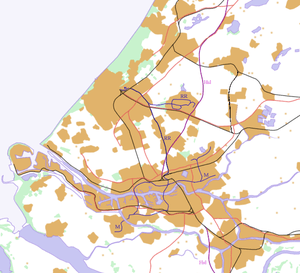Delft railway station
Delft | |||||||||||||||||||||||||||||||||||||||||||
|---|---|---|---|---|---|---|---|---|---|---|---|---|---|---|---|---|---|---|---|---|---|---|---|---|---|---|---|---|---|---|---|---|---|---|---|---|---|---|---|---|---|---|---|
|
| |||||||||||||||||||||||||||||||||||||||||||
| Location | Netherlands | ||||||||||||||||||||||||||||||||||||||||||
| Coordinates | 52°00′24″N 4°21′24″E / 52.00667°N 4.35667°ECoordinates: 52°00′24″N 4°21′24″E / 52.00667°N 4.35667°E | ||||||||||||||||||||||||||||||||||||||||||
| Operated by | Nederlandse Spoorwegen | ||||||||||||||||||||||||||||||||||||||||||
| Line(s) | Amsterdam–Rotterdam railway | ||||||||||||||||||||||||||||||||||||||||||
| Platforms | 1 island platform | ||||||||||||||||||||||||||||||||||||||||||
| Tracks | 2 | ||||||||||||||||||||||||||||||||||||||||||
| Bus stands | 8 | ||||||||||||||||||||||||||||||||||||||||||
| Connections |
| ||||||||||||||||||||||||||||||||||||||||||
| Construction | |||||||||||||||||||||||||||||||||||||||||||
| Bicycle facilities | Free parking for 8,700 bicycles, of which 5,000 underground[1] | ||||||||||||||||||||||||||||||||||||||||||
| Architect | Francine Houben (Mecanoo archit.) | ||||||||||||||||||||||||||||||||||||||||||
| Other information | |||||||||||||||||||||||||||||||||||||||||||
| Station code | Dt | ||||||||||||||||||||||||||||||||||||||||||
| History | |||||||||||||||||||||||||||||||||||||||||||
| Opened | 31 May 1847 | ||||||||||||||||||||||||||||||||||||||||||
| Rebuilt | 1885, 2015 | ||||||||||||||||||||||||||||||||||||||||||
| Services | |||||||||||||||||||||||||||||||||||||||||||
| |||||||||||||||||||||||||||||||||||||||||||
| Location | |||||||||||||||||||||||||||||||||||||||||||
 | |||||||||||||||||||||||||||||||||||||||||||
Delft is the main railway station of Delft, the Netherlands, located on a section of the oldest railway line in the country, between the cities of The Hague and Rotterdam. Along with a new 2.3 km rail tunnel under the city centre, the current station opened on 28 February 2015.[2] The new building, which integrates the station hall with the city's municipal offices, was designed by Mecanoo, an international architecture firm that originated in Delft. The project also included a rebuilt bus station, tram stops and improved bicycle parking.
Previous stations

The initial Delft railway station was located on the Houttuinen, close to the current building. The first train passed through it on 31 May 1847, and just days later, on 3 June, the station opened its doors to the public. Because of increasing numbers of passengers and goods transported, a new, larger railway station had to be opened in 1885, just to the south of the original station. The latter building was designed by Christiaan Posthumus Meyjes sr..
The old station building has gained monumental status, and will be repurposed with a commercial hospitality function.
Railway zone project in Delft

From 1964, the railway through Delft ran on a double track viaduct, created to eliminate level crossings, intending to improve the safety and fluidity of traffic through the city. However, the rail viaduct became unpopular for being visually unattractive, and because the line through Delft is very busy, meaning between 300 and 350 trains passing daily caused major noise pollution. Therefore, a large urban design project was formulated in 1999, designed by Spanish urban planner Joan Busquets, which will see the rail viaduct replaced by two tunnels.
The first phase of this has been completed in February 2015, and sees a first tunnel tube with two rail tracks in operation. By 2020 the decommissioned viaduct will be torn down, and a second tunnel tube with two more rail tracks will be constructed underneath the path previously occupied by it. Redevelopment of the freed up space above ground, has not yet been fully planned.
Train services
The following services call at Delft:
- 1x per hour night service (nachtnet) Rotterdam - The Hague - Amsterdam - Utrecht
- 2x per hour Intercity service The Hague - Rotterdam - Dordrecht - Breda - Eindhoven - Venlo
- 2x per hour Intercity service Amsterdam - Haarlem - Leiden - The Hague - Rotterdam - Dordrecht
- 2x per hour Intercity service Lelystad - Almere - Amsterdam - Schiphol - The Hague - Rotterdam - Dordrecht - Roosendaal - Vlissingen
- 2x per hour local service (sprinter) The Hague - Rotterdam - Dordrecht - Breda
- 2x per hour local service (sprinter) The Hague - Rotterdam - Dordrecht - Roosendaal
Connections
- Tram 1: Delft Tanthof - Delft - Rijswijk - The Hague - Scheveningen
- Bus 32: Delft - Den Hoorn - De Lier - Naaldwijk
- Bus 37: Delfgauw Ruyven - Delft - Den Hoorn - The Hague Leyenburg
- Bus 38: Delft - Den Hoorn - Maasland
- Bus 40: Delft - Overschie - Rotterdam
- Bus 55: Delft - TU Delft - Pijnacker Centrum - Zoetermeer
- Bus 60: Delft Tanthof - Delft - Nootdorp
- Bus 69: Delft - TNO - TU Delft
- Bus 80: Delft Tanthof - Delft - IKEA - Olof Palmestraat
- Bus 81: IKEA - Delft - Kuyperwijk
- Bus 82: Delft - Delft Tanthof - Delft Zuid - Voorhof
- Bus 130: Delft - Rijswijk - The Hague
- Bus 174: Delft - TU Delft - Pijnacker Zuid - Berkel Westpolder - Berkel - Rotterdam Noord
Gallery
References
- ↑ Train Tunnel News - Delft.nl
- ↑ "Nieuw station Delft open". SpoorzoneDelft. 28 February 2015. Retrieved 28 February 2015.
External links
| Wikimedia Commons has media related to Station Delft. |
- NS website (Dutch)
- Dutch Public Transport journey planner (Dutch)
| Dutch Rijksmonument 525335 |
